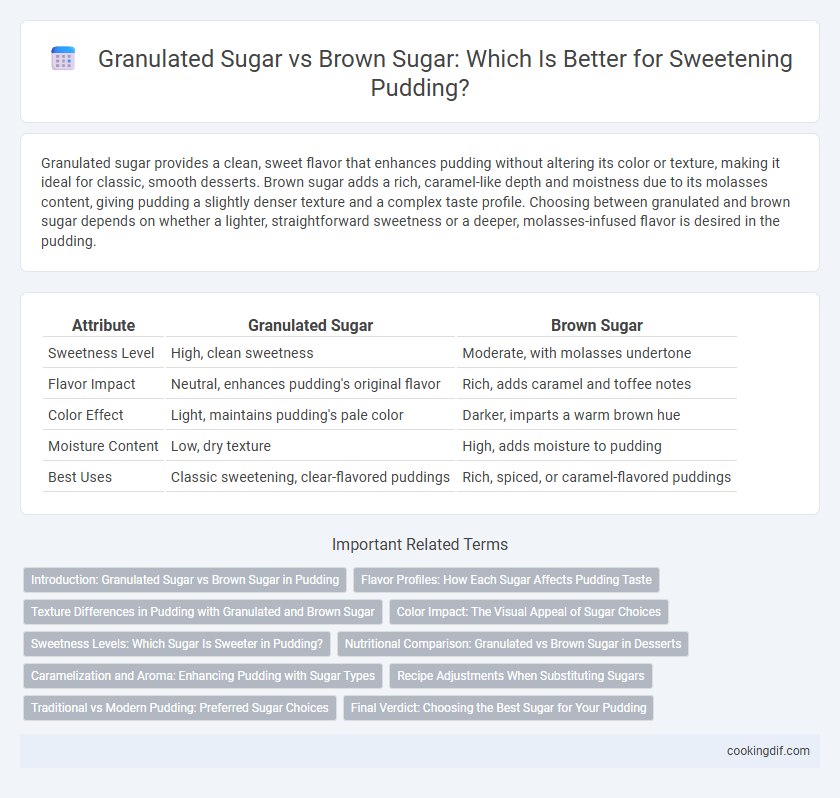Granulated sugar provides a clean, sweet flavor that enhances pudding without altering its color or texture, making it ideal for classic, smooth desserts. Brown sugar adds a rich, caramel-like depth and moistness due to its molasses content, giving pudding a slightly denser texture and a complex taste profile. Choosing between granulated and brown sugar depends on whether a lighter, straightforward sweetness or a deeper, molasses-infused flavor is desired in the pudding.
Table of Comparison
| Attribute | Granulated Sugar | Brown Sugar |
|---|---|---|
| Sweetness Level | High, clean sweetness | Moderate, with molasses undertone |
| Flavor Impact | Neutral, enhances pudding's original flavor | Rich, adds caramel and toffee notes |
| Color Effect | Light, maintains pudding's pale color | Darker, imparts a warm brown hue |
| Moisture Content | Low, dry texture | High, adds moisture to pudding |
| Best Uses | Classic sweetening, clear-flavored puddings | Rich, spiced, or caramel-flavored puddings |
Introduction: Granulated Sugar vs Brown Sugar in Pudding
Granulated sugar offers a clean, sweet flavor and dissolves quickly, ideal for smooth pudding textures. Brown sugar introduces molasses notes and moisture, resulting in a richer, creamier consistency and deeper color. Choosing between granulated and brown sugar affects the pudding's sweetness profile and overall mouthfeel.
Flavor Profiles: How Each Sugar Affects Pudding Taste
Granulated sugar provides a clean, straightforward sweetness that enhances pudding without altering its base flavor, making it ideal for recipes that rely on subtle, creamy notes. Brown sugar adds a rich, caramel-like depth due to its molasses content, imparting a slightly complex, toffee-like taste that complements richer or spiced puddings. Choosing between granulated and brown sugar directly influences the pudding's overall flavor profile, with granulated sugar maintaining purity and brown sugar introducing warmth and complexity.
Texture Differences in Pudding with Granulated and Brown Sugar
Granulated sugar creates a smoother, lighter texture in pudding by dissolving evenly and contributing to a clean sweetness without altering consistency. Brown sugar adds moisture and a denser, creamier texture due to its molasses content, which also imparts a rich, caramel-like flavor. The choice between granulated and brown sugar significantly impacts the pudding's mouthfeel and overall sensory experience.
Color Impact: The Visual Appeal of Sugar Choices
Granulated sugar creates a lighter, more translucent pudding that highlights the dish's natural color and creamy texture, enhancing overall visual appeal. Brown sugar imparts a rich amber hue, giving the pudding a warm, caramelized appearance that suggests deeper flavors and a more rustic, homemade quality. Choosing between granulated and brown sugar allows precise control over pudding color, influencing both presentation and perceived taste.
Sweetness Levels: Which Sugar Is Sweeter in Pudding?
Granulated sugar has a higher sweetness level compared to brown sugar, making it ideal for achieving a more pronounced sweet flavor in pudding. Brown sugar contains molasses, which adds moisture and a slightly caramelized, less intense sweetness that can deepen the pudding's flavor profile. For a sweeter pudding, granulated sugar is preferred, while brown sugar offers a richer, more complex taste with moderate sweetness.
Nutritional Comparison: Granulated vs Brown Sugar in Desserts
Granulated sugar and brown sugar differ significantly in nutritional content, with brown sugar containing slightly more minerals like calcium, potassium, and iron due to its molasses content. Both sugars are high in calories and carbohydrates, but brown sugar has marginally higher moisture, affecting the texture and sweetness intensity in puddings. Choosing granulated sugar results in a more neutral sweetness, while brown sugar imparts a richer flavor and a subtle caramel note, influencing both taste and nutritional value.
Caramelization and Aroma: Enhancing Pudding with Sugar Types
Granulated sugar caramelizes at a higher temperature, producing a cleaner, sweeter flavor that enhances the pudding's smooth texture without overpowering its delicate taste. Brown sugar, containing molasses, caramelizes at a lower temperature and adds a rich, deep aroma along with a hint of moisture, resulting in a more complex and robust pudding flavor. Choosing between granulated and brown sugar can significantly affect pudding's caramelization process and aromatic profile, tailoring the dessert to different sensory preferences.
Recipe Adjustments When Substituting Sugars
When substituting granulated sugar with brown sugar in pudding recipes, it's essential to reduce the liquid slightly due to brown sugar's higher moisture content. Brown sugar adds a rich, caramel-like flavor, which may require adjusting spices or vanilla to balance sweetness. Using granulated sugar results in a cleaner, more neutral sweetness, often producing a lighter texture in the final pudding.
Traditional vs Modern Pudding: Preferred Sugar Choices
Traditional pudding recipes often favor brown sugar for its rich molasses flavor and moist texture, enhancing the dessert's depth and complexity. Modern pudding variations tend to use granulated sugar, prized for its clean sweetness and ability to dissolve quickly, creating a smoother consistency. The choice between granulated and brown sugar significantly influences the pudding's taste profile and texture, with brown sugar imparting warmth and granulated sugar delivering a lighter, more neutral sweetness.
Final Verdict: Choosing the Best Sugar for Your Pudding
Granulated sugar provides a clean, straightforward sweetness that enhances the pudding's texture without altering its color, making it ideal for classic vanilla or chocolate puddings. Brown sugar introduces a rich, caramel-like flavor and deeper color, perfect for warm, spiced, or butterscotch puddings that benefit from added complexity. Choosing the best sugar depends on the desired flavor profile and appearance, with granulated sugar favored for simplicity and brown sugar preferred for depth and warmth.
Granulated sugar vs brown sugar for sweetening pudding Infographic

 cookingdif.com
cookingdif.com